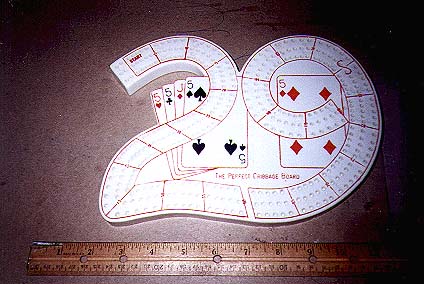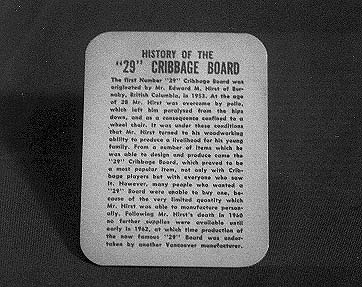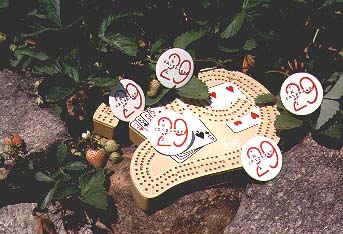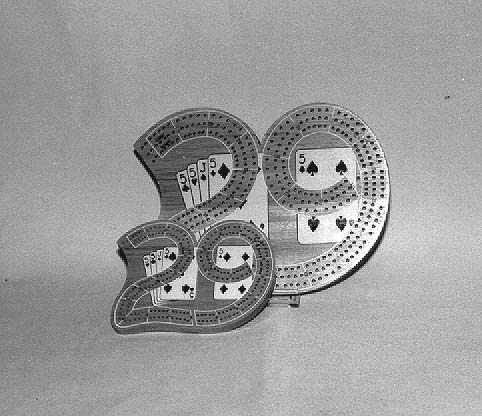♠ Article Library ♦ Board Gallery

Perhaps no cribbage board design has ever generated more interest among people, young and old alike, than the "29" board. Featuring a once-around 120 hole track, the board is easy to play on , with little chance for error. Giving strength to that feature, your opponent can't claim that you're still on second street if he/she is lagging behind, for the board doesn't lie! 120 holes you see, 120 holes you peg, with the peg-out hole (#121) bringing home the win.
The history of the board and the progressive sequence of its manufacture from Canada to the U.S., and finally to the Asian countries is quite interesting. In the field of cribbage board collecting, we have tracked this progressive sequence not only with the "29" board but also with all of the most popular and inexpensive boards in use today (with the exception of the tournament long board). My observations lead me to believe that the tournament board will be the next design to exit the manufacturing process in this country and move to Asia. Being a "Made in the USA" fanatic, I can only hope that my observations are incorrect.
Many variations to the "29" board have been manufactured all over the world, but most people are not aware of how or by whom the design was first created. Once upon a time, in Burnaby British Columbia, lived a man called Edward M. Hirst. Mr. Hirst was overcome by polio when he was 28 years old and spent the rest of his life in a wheelchair. He was an avid woodworker, and in 1953 he designed the first "29" board. From that point on until his death in 1960, he was kept busy trying to keep up with the demand for this very popular and uniquely designed board. It has been said that folks would wait months for their order to be filled, because he hand-crafted every board by himself. The fact that the board wasn't mass-produced until after his death, indicates that Mr. Hirst may have had the foresight to register his design. A firm located in Vancouver, quite possibly Ryco Sales Ltd., began mass producing the board in 1962, two years after Mr. Hirst's death. The history of the "29" board might have been lost forever but for the fact that another Canadian company, Somerville Industries, attached a card with its' history to the "29" board (called 'THE PERFECT CRIBBAGE BOARD') that they manufactured. (See photos) Not long after Somerville began producing the board, in 1964, the company was purchased by Milton Bradley Co. of Springfield, MA. It doesn't appear that Milton Bradley ever continued its' production. Somerville and Ryco are the only known Canadian manufacturers of the "29" board, and both companies featured the 5 of Diamonds as the cut card.

In the progressive steps of manufacture, the United Stated became home to the next generation of the manufacturing process, with three firms known to have manufactured it. Pacific Game Co. manufactured a plastic version in the early 1970's which had a compartment on the bottom for a deck of cards, and featured a 5 of hearts as the cut card. (See photo) Crisloid, Inc. manufactured a wooden version with a 5 of diamonds, which they labeled "Official Mister Cribbage Board". The Drueke Co. is also known to have manufactured the board, but no photos have been supplied to the CBCS thus far. We would appreciate receiving any information which readers may have on this model for our archives.

In the progressive movement of the board's manufacture, the final stage naturally moves to the Asian countries, most commonly Taiwan. American manufacturers such as Crisloid eventually found that they couldn't mass produce the board as cheaply as it could be done in Taiwan, even when the import tariffs were included in the price. When production stopped here, the sale of the boards generally moved to American venders rather than manufacturers. The venders most commonly associated with the sale of the "29" board have included John N. Hansen Co., (see photo), Pressman, Baron/Scott Enterprises, Hoyle Products, Ken's Importers and Distributors and Ely Distributing Co. Some of the venders, such as Hansen, have their Logo imprinted of the boards that they sell, which helps with the identification.

All "29" boards are basically identical in size and feature the "29" hand on the face. There are three styles - the classic board, the board with card storage(the same size as the classic), and a mini board which is ideal for use as a travel board. The variations, which are minor, include the suit of the cut card used by the various companies. The diamond, heart and spade have been used, but not the 5 of clubs, to our knowledge. The face of the 2 was fully open on the Canadian boards, but is only partially open or is fully closed on the Taiwan boards. The wood used in the Taiwan boards is lighter in weight, and the card-holding boards tend to crack easily across the face.
There is one unidentified metal "29" board located right here in my neighborhood. Vicki, our local postal clerk, brought it to my attention one day, and she even allowed me to borrow it so that I could examine it closely. If ever I was tempted to forget where it came from - oh well. It is hollow on the underside, there is no paint on it, no indication of who the manufacturer was, and the cut card is the 5 of diamonds. What a treasure - and her daughter has already laid claim to it when her parents no longer care to play the game. Guess I'll have to keep checking yard sales and flea markets , just in case there's another one floating around somewhere!In 1875, McLaughlin Bros. Issued a game called "Cribbage Authors". It included a deck of 72 cards divided into 18 books. Each book contained the name and works of one author only, and the books were of various colors. Although the instructions are available, no decks of cards have been reported. Should anyone own a deck, I would appreciate hearing more about the card from them.
Once again, I hope that you have enjoyed my account of the historical events surrounding the "29" board. A big thanks to Tom O'Gara, a member of the CBCS, for the use of some of his photos.